8 Flowering Vines to Grow in New Jersey
If you are looking for something to add color and beauty to your garden, consider planting flowering vines. Many different types of vines can be grown in New Jersey, and some are quite easy to care for. Vines also make for good erosion control and nitrogen-fixing plants. Here are some flowering vines that you can consider growing.
Best Flowering Vines for New Jersey
Hyacinth Bean (Dolichos Lablab)
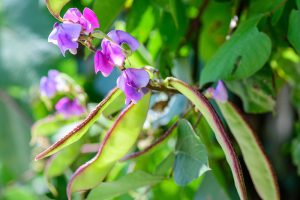
The hyacinth bean (Dolichos lablab) is a climbing vine that produces clusters of vibrant purple flowers. The flowers are followed by edible pods that contain large black beans. The hyacinth bean is native to tropical Africa and Asia but has been widely cultivated for centuries in other parts of the world. Today, it is commonly grown as an ornamental plant, but it is also used as a food crop in many parts of Africa and Asia. The beans can be eaten fresh or cooked, and they are a good source of protein. The leaves of the plant are also edible and are often used as a green vegetable in soups and stews. In addition to its culinary uses, the hyacinth bean is also known for its medicinal properties. The beans and leaves have been traditionally used to treat various ailments, including diarrhea, malaria, and coughs. The hyacinth bean is a versatile plant with a long history of cultivation and uses worldwide.
Moonseed (Menispermum Canadense)

Moonseed (Menispermum canadense) is a native North American climbing vine found in wooded areas from Nova Scotia to Ontario and north to Minnesota. The plant gets its common name from the shape of its dark blue fruit, which resembles a crescent moon. Moonseed is a deciduous vine that can grow up to 30 feet in length. The leaves are alternate, simple, and ovate-shaped with finely serrated margins. The small white flowers are borne in clusters of 3-6 and bloom in June. The fleshy fruits mature in August and are eaten by many animals, including birds, squirrels, and opossums. The fruit is a dark blue berry that contains a single seed. The seed is poisonous and should not be eaten. Moonseed can be confused with other plants, so it is important to be able to identify it correctly. If you are ever in doubt, it is best to err on the side of caution and avoid consuming any part of the plant.
Tara Vine (Actinidia Arguta)

The tara vine (Actinidia arguta) is a fast-growing, woody vine native to China. It was introduced to North America in the early 1900s and has since become naturalized in many parts of the United States. Tara vine has glossy, dark green leaves and small, white flowers borne in clusters. The plant’s fruit is round and orange, with a thin skin and juicy flesh. Tara vine is tolerant of a wide range of climates and soil types but prefers well-drained soil and full sun. It is relatively disease-resistant but can be susceptible to powdery mildew if conditions are too humid. Tara vine can be propagated from seed or cuttings and can be trained to grow on a trellis or other support structure. For best results, plant Tara vines in early spring, so they have time to establish before the summer heat sets in. It is important to prune the vine regularly to keep it under control. The tara vine is relatively easy to care for and makes an attractive addition to any garden.
Matrimony Vine (Lycium Halimifolium)
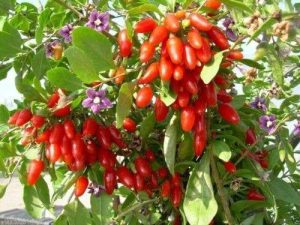
The Matrimony vine is a fast-growing shrub reaching up to 15 feet. The Matrimony vine is native to Europe and Asia but has been introduced to North America. It has a many-branched, twiggy growth habit and small, dark green leaves. The stems are armed with sharp thorns, and the plant produces small white flowers in the spring. The fruit of the Matrimony vine is a red berry about 1/2 inch in diameter. The berries are edible and have a sweet taste. This hardy plant can grow in habitats, including disturbed areas such as roadsides and construction sites. It reproduces via seed; each plant can produce tens of thousands of seeds annually. Once established, the Matrimony vine is difficult to control and can crowd out native vegetation.
For this reason, it is important to be cautious when planting this species in your garden. The Matrimony vine is an important food source for birds and other animals. In addition, the roots of the Matrimony vine have been used medicinally by Native Americans for centuries. Today, the Matrimony vine is grown as an ornamental plant in gardens all over the world.
Japanese Wisteria (Wisteria Floribunda)
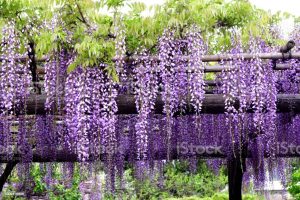
Wisteria floribunda, also known as Japanese wisteria, is a species of flowering plant in the pea family Fabaceae. It is native to Japan, where it is called “Fuji.” Wisteria floribunda is a woody, deciduous vine. It can grow to 30 m (98 ft) in length over many supports, such as trees, fences, and trellises. The plant produces fragrant purple flowers that bloom in clusters in late spring or early summer. The flowers are followed by long, thin bean-like pods that mature in late summer and can be used in dried flower arrangements. The leaves are compounded with 9-19 oval-shaped leaflets. The flowers are clustered together in racemes that can be up to 60 cm long. They are typically violet-purple, but white-flowered varieties also exist. The fruit is a brown pod that is 15-25 cm long and contains several seeds. Japanese wisteria is a popular ornamental plant in gardens and parks. It can be invasive if not properly controlled.
Beach Pea (Lathyrus Japonicus)

The Beach pea (Lathyrus japonicus) is a flowering plant in the legume family. It is native to the coasts of Asia and certain parts of Europe. The Beach pea is a hardy plant that can grow in various habitats, including sandy beaches, cliffs, and dunes. The Beach pea has bright green leaves and small, purple flowers. Bees and other pollinators often visit the flowers. The Beach pea is an annual plant that completes its life cycle within one growing season. The Beach pea is a nitrogen-fixing plant that helps improve the quality of the soil it grows. The Beach pea is also edible, both raw and cooked. When cooked, the peas have a nutty flavor and can be used in a variety of dishes.
Kolomikta Actinidia (Actinidia Kolomikta)
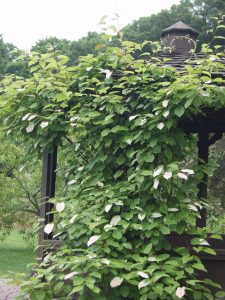
Kolomikta Actinidia (Actinidia kolomikta) is a species of climbing vine native to northeastern Asia. It is in the same family as the more familiar kiwifruit (Actinidia deliciosa). The plants are dioecious, meaning that they have separate male and female specimens. Flowers are small and white, borne in clusters of 3-5. The Kolomikta Actinidia has compound leaves with 3-5 leaflets, each of which is 2-3 inches long and deeply lobed. The most notable feature of kolomikta actinidia is its variegated leaves, which are often pink, green, and white. The fruits of the plant are orange-red berries, around 1 cm in diameter. Kolomikta actinidia is often cultivated as an ornamental plant due to its attractive leaves. However, the plant can also be used for culinary purposes, as the berries can be made into jams and jellies. Kolomikta actinidia is a fast-growing vine and can reach lengths of up to 20 m, given sufficient support. The plant is also relatively easy to care for, making it a popular choice for home gardens.
Morning Glory (Ipomoea Tricolor)
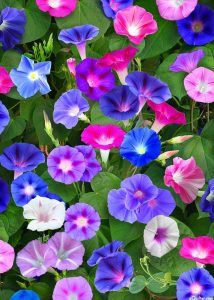
Morning glory (Ipomoea tricolor) is a flowering plant in the family Convolvulaceae, native to tropical and subtropical regions throughout the world. The species includes wide varieties and cultivars, including the common “Herald of Summer” morning glory. The plant grows as a twining vine, reaching a height of 10-15 feet (3-4.5 meters). The leaves are 2-6 inches (5-15 cm) long and 1-3 inches (2.5-7.5 cm) wide, with a pointed tip and smooth edges. The flowers are 3-4 inches (7.5-10 cm) across, with five petals that are generally striped with white, pink, and blue. Morning glories bloom in summer and fall, and the flowers typically last for only one day. The fruit is a small capsule containing several seeds. Morning glory is often grown as an ornamental plant, but it can also be invasive in some areas. Morning glories are not difficult to grow from seed, and they will self-seed readily if given the opportunity. Once established, they are very drought tolerant.
How to Care for Vines
While vines are generally easy to care for, there are a few important considerations to keep in mind when growing them. First, choosing the right type of vine for your climate and soil is important. Certain vines are more tolerant of cold weather or poor soil than others, so it is important to do your research before planting. After choosing the perfect spot to plant your vines, it is important to take the proper steps to ensure they will thrive. Loosen the soil and mix in some compost or other organic matter when preparing the planting hole. This will help the roots to establish themselves more quickly. It is also important to water the vines regularly, especially during the first growing season. Once the vines are established, they will need very little supplemental water. To encourage flowering and fruit production, one should ensure there is a yearly application of a balanced fertilizer. Finally, it is important to prune the vines regularly to encourage new growth and prevent the plant from becoming overcrowded. Your vines will provide years of beauty and enjoyment with a little care and attention.
Pest Diseases that Affect Vines
There are several diseases and pests that may affect vines. Powdery mildew is a common fungal disease that affects leaves, stems, and fruits. It is characterized by white or grayish powdery spots on the plant surface. To control this, one should remove affected leaves and avoid overcrowding vines. Another common disease is black rot, which causes dark lesions on leaves, stems, and fruits. This disease can be controlled by removing affected plant parts and avoiding injury to vines. Pests that may affect vines include aphids, spider mites, and leafhoppers. These pests can cause stunted growth, deformities, and decreased yields. This can be controlled by removing infested plant parts and using insecticide sprays. It is also important to take preventive measures such as keeping the vines clean and debris-free. By being aware of the potential problems and taking steps to prevent them, growers can help ensure that their vines remain healthy and productive.
Bottom Line
Flowering Vines not only add beauty and aesthetics to a garden, but they can also be instrumental in erosion control and nitrogen fixation. There are many different species of flowering vines, each with its unique bloom time and color. When choosing a vine, it is important to consider the plant’s growth habit, flower color, and bloom time. However, it is also important to be aware of the potential problems that may affect them. By taking preventive measures and being diligent in their care, growers can help ensure that their vines remain healthy and productive.
